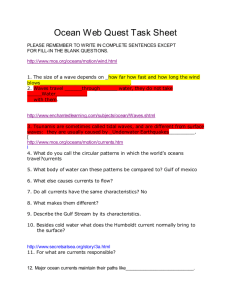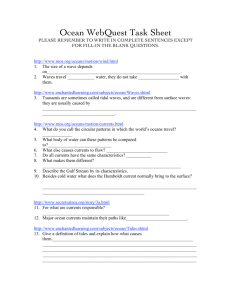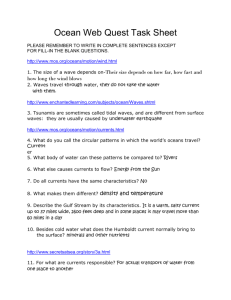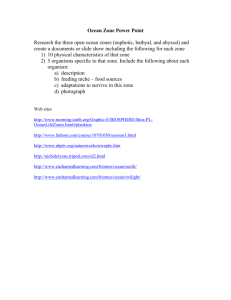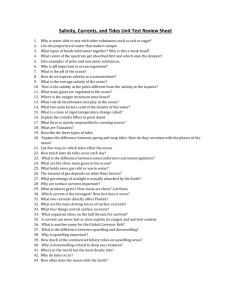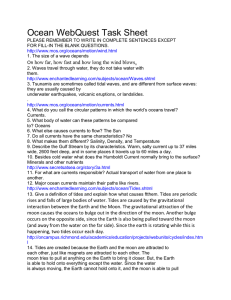Ocean WebQuest Task Sheet PLEASE REMEMBER TO WRITE IN
advertisement
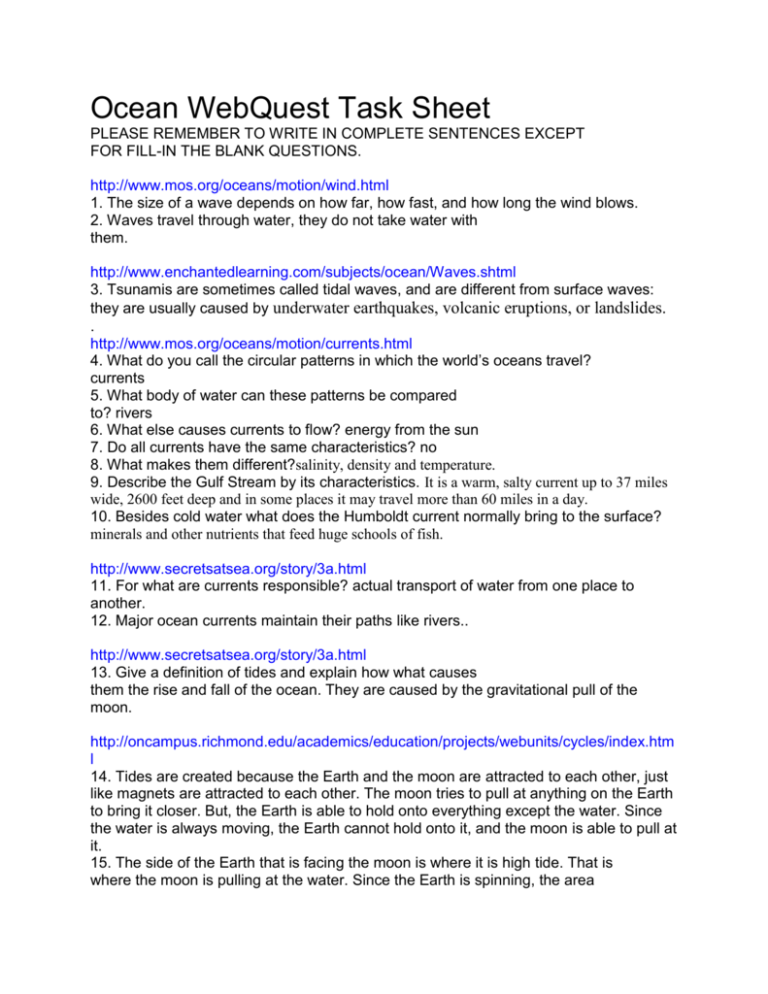
Ocean WebQuest Task Sheet PLEASE REMEMBER TO WRITE IN COMPLETE SENTENCES EXCEPT FOR FILL-IN THE BLANK QUESTIONS. http://www.mos.org/oceans/motion/wind.html 1. The size of a wave depends on how far, how fast, and how long the wind blows. 2. Waves travel through water, they do not take water with them. http://www.enchantedlearning.com/subjects/ocean/Waves.shtml 3. Tsunamis are sometimes called tidal waves, and are different from surface waves: they are usually caused by underwater earthquakes, volcanic eruptions, or landslides. . http://www.mos.org/oceans/motion/currents.html 4. What do you call the circular patterns in which the world’s oceans travel? currents 5. What body of water can these patterns be compared to? rivers 6. What else causes currents to flow? energy from the sun 7. Do all currents have the same characteristics? no 8. What makes them different?salinity, density and temperature. 9. Describe the Gulf Stream by its characteristics. It is a warm, salty current up to 37 miles wide, 2600 feet deep and in some places it may travel more than 60 miles in a day. 10. Besides cold water what does the Humboldt current normally bring to the surface? minerals and other nutrients that feed huge schools of fish. http://www.secretsatsea.org/story/3a.html 11. For what are currents responsible? actual transport of water from one place to another. 12. Major ocean currents maintain their paths like rivers.. http://www.secretsatsea.org/story/3a.html 13. Give a definition of tides and explain how what causes them the rise and fall of the ocean. They are caused by the gravitational pull of the moon. http://oncampus.richmond.edu/academics/education/projects/webunits/cycles/index.htm l 14. Tides are created because the Earth and the moon are attracted to each other, just like magnets are attracted to each other. The moon tries to pull at anything on the Earth to bring it closer. But, the Earth is able to hold onto everything except the water. Since the water is always moving, the Earth cannot hold onto it, and the moon is able to pull at it. 15. The side of the Earth that is facing the moon is where it is high tide. That is where the moon is pulling at the water. Since the Earth is spinning, the area that the moon is pulling at changes. That is why the tides change. If you are at the beach, and the moon is pulling on the ocean there, it will be high tide. If the moon is pulling at the ocean somewhere else, then it will be low tide at the beach where you are. 16. How do we know that the water nearest to the moon forms a bulge? Because of the pull of the moon. 17. Where else does the water form a bulge? The other side of the earth. 18. How many tides are there each day? 4 19. How much time is there between tides? 12 hours 25 minutes http://www.enchantedlearning.com/subjects/weather/hurricane/landfall.shtml 20. What is a storm surge? A storm surge is a rise in the ocean as the result of strong winds from a hurricane or other intense storm 21. What can be the most dangerous part of a hurricane? the eye wall http://www.ocean.udel.edu/extreme2002/ 23. Dive in mission to the abyss: go to seafloor geology then click on the Quicktime video to see a real undersea volcano. Click on The Deep Ocean, Mid-Ocean Ridge, Plate Tectonics and Hydrothermal Vents. Pay attention and take notes on things you’d like to include in your model of the ocean floor. Remember your model should include: continental shelf/rise/slope, mid-Atlantic ridges, rifts and trenches. http://projects.edtech.sandi.net/valencia/explore/ocean_layers.html 24. Sketch the diagram at this site to help you in building your ocean floor model. http://www.enchantedlearning.com/subjects/astronomy/planets/earth/Continents.shtml 25. You have been given two diagrams. Read the definitions then label the outer layers of the Earth and the seafloor spreading (plate divergence) diagrams. http://www.enchantedlearning.com/subjects/astronomy/activities/radiobuttonquiz/Tecton i cspz.shtml 26. Take this on-line quiz about plate tectonics. Record your score here . http://www.amnh.org/nationalcenter/expeditions/blacksmokers/gallery.html 27. At this site view underwater photos and video clips from ocean floor volcanoes called smokers. Which of the three videos is best. Fully describe what is happening in the video you selected as being best. http://www.windows.ucar.edu/tour/link=/earth/interior/plate_tectonics.html 28. This picture shows how the rigid outer layer of the Earth, called the , is made of plates which fit together like a jigsaw puzzle. 29. Of what are these plates made? _____________________ 30. What allows the plates to "float" on top of the denser material? ___________________________________________________________________ _______________________________________________________________ http://www.mos.org/oceans/planet/features.html 31. What is the Average Depth of the ocean? ____________________________________________________ 32. What is the Deepest point and where is it? ___________________________________________________ 33. What is the highest Mountain and where is it? _______________________________________________ 34. Around most continents are shallow seas that cover gently sloping areas. What are these areas called?_______________________________________________ ______________________________________________________________ 35. Where do the continental shelves end? ___________________________________________________________________ 36. What is beyond the continental slope? ___________________________________ 37. Describe the abyss in a complete paragraph. __________________________________________________________________ ____________________________________________________________________ ____________________________________________________________________ ____________________________________________________________________ ____________________________________________________________________ ____________________________________________________________________ 38. What are the deepest parts of the oceans called? ____________________________________________________________________
